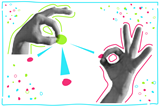How research into students’ reasoning can improve your teaching

Interpreting spectroscopic data as supporting evidence is a key aspect of chemistry practice. As such, spectroscopy is a crucial topic in any undergraduate programme, and in many post-16 school curriculums. However, invalid assumptions and reasoning can prevent students from fulfilling their potential in spectral interpretation. In a new study, the Shultz group characterises students’ reasoning when tackling spectroscopic problems, identifying flawed approaches and their origins.
The study involved 18 undergraduates in an American university. They completed tasks entailing the scrutiny of infrared (IR) and 1H nuclear magnetic resonance (NMR) spectra to determine whether the synthesis of a target molecule had been successful.
Eye-tracking technology recorded students’ interactions with the spectra as they tackled the problems. The researchers then interviewed the students while the students watched the recordings of their own eye movements. The recordings supported the students to verbalise what their thought processes were as they completed the tasks.
The published interview data provides valuable insight into the thought processes of students during the study. The research group’s analysis will interest anyone who teaches spectroscopy.
Heuristic hiccups
One issue they uncovered was that students applied the ‘N + 1 rule’ too rigidly. The research team chose spectra with challenging features for the tasks. N—H splitting effects, a complex aromatic signal and an alkene group presenting signals that ‘contravene’ the rule led students to misinterpret these aspects of the data. Another significant issue was that students assumed IR peaks should be prominent if a functional group is present. ‘Smaller’ peaks introduced doubt into students’ minds and impaired their reasoning. Some students considered multiple features, but based their final decision on only one of them. This is known as ‘one-reason decision making’, and it particularly struck a chord with my teaching experience.
The study drew on prior investigations into invalid student assumptions and heuristic reasoning strategies in chemistry. Heuristics simplify and reduce the effort of decision making. When used appropriately, heuristics allow us to tackle laborious challenges efficiently. Experts employ heuristics appropriately more often than students. Heuristic reasoning can be classified into Type 1 and Type 2 processing. Type 1 is automatic, whereas Type 2 is slow and systematic with a high working memory tariff. The article emphasises the importance of moving students from Type 1 to Type 2 processing for success in interpreting spectra.
Teaching tips
NMR spectra used in school-level exams tend to be unambiguous; the signals ‘obey the rules’. So, you could argue that the Shultz group’s spectra, which involve exceptions to the rules, make their research irrelevant to secondary teaching. However, it is possible that overly simple examples cement the rigid thinking that constrains reasoning when ‘real’ problems are encountered. Such thinking will be problematic later on, even for students who pursue medicine, for example, rather than chemistry.
With that in mind, try adapting the activities outlined in the article for a post-16 class. In their article, the researchers recommend explicitly addressing students’ assumptions during instruction to actively promote a shift from Type 1 to Type 2 processing. To facilitate this, encourage students to:
- consider the opposite of any decision they are about to make (this helps them to navigate away from any misapplied invalid assumptions and heuristics);
- evaluate their confidence in their answer (research shows that individuals with low confidence have longer rethinking times and a higher tendency to change their answer);
- predict how adopting a flawed approach might respond to a question (this has also been shown to positively influence performance).
Beyond this, we could all benefit from better understanding heuristics’ role in constraining our students’ thinking around a range of challenging topics. This could be addressed with appropriate CPD. Teachers could then demonstrate to students the role of problematic heuristics in erroneous decision making.
References
M C Connor, S A Finkenstaedt-Quinn and G V Shultz, Chem. Educ. Res. Pract., 2019, DOI: 10.1039/c9rp00033j














No comments yet